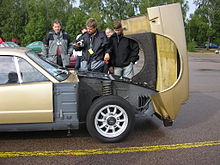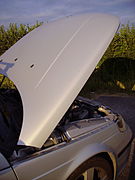Hood (car)
This article needs additional citations for verification. (March 2015) |

The hood (
Terminology
In British terminology, hood refers to a fabric cover over the passenger compartment of the car (known as the 'roof' or 'top' in the US). In many motor vehicles built in the 1930s and 1940s, the resemblance to an actual hood or bonnet is clear when open and viewed head-on. In modern vehicles it continues to serve the same purpose but no longer resembles a head covering.
Styles and materials
On front-engined cars, the hood may be hinged at either the front or the rear edge, or in earlier models (e.g. the Ford Model T) it may be split into two sections, one each side, each hinged along the centre line. Another variant combines the bonnet and wheelarches into one section which allows the entire front bodywork to tilt forwards around a pivot near the front of the vehicle (e.g. that of the Triumph Herald).[1]
Hoods are typically made of the same material as the rest of the body work. This may include
Release/ safety and security mechanisms
The hood release system is common on most vehicles and usually consists of an interior hood latch handle, hood release cable and hood latch assembly. The hood latch handle is usually located below the steering wheel, beside the driver's seat or set into the door frame. On race cars or cars with aftermarket hoods (that do not use the factory latch system) the hood may be held down by hood pins. Some aftermarket hoods that have a latch system are still equipped with hood pins to hold the hood buttoned down if the latch fails.
Features

A hood may contain a hood ornament, hood scoop, and/or wiper jets. A portion of the hood may be raised in a power bulge, to fit a large engine or air filters.
Pedestrian safety
In Japan and Europe, regulations have come into effect that place a limit on the severity of pedestrian head injury when struck by a motor vehicle.
-
Some hoods may need a power bulge to fit over the engine and air filters, or enhance the aesthetic appearance of the hood
-
A flipfront hood
-
A rear-hinged clamshell hood on a Saab 9-5
See also
- Front-end bra
- List of auto parts
- Trunk (automobile)
References
- ^ Huddy, S. G. J. (15 February 2012). "Brent Knoll". Trains, ferries, buses. UK. Retrieved 2 November 2019.
- ^ Teng, Tso Liang; Liang, Cho-Chung; Shih, Chien-Jong; Nguyen, Manh-Trung (January 2013). "Design of car hood of sandwich structures for pedestrian safety". Retrieved 2 November 2019.






